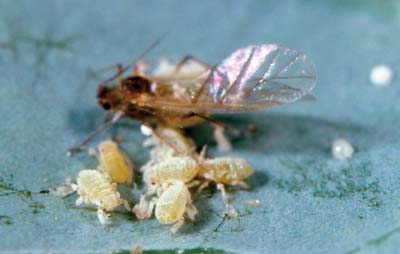To save the Web-optimized images shown below to your hard drive:
|
Click to access Display and Print quality images. |
Vegetable crops that are commonly attacked by the cabbage aphid include broccoli, Brussels sprouts, cabbage, cauliflower, collards, kale, kohlrabi, mustard, rape, and turnip. Plant leaves will commonly wrinkle and curl, eventually cupping. Younger tissue is usually preferred. The cabbage aphid is capable of transmitting over 30 plant viruses. Populations of the cabbage aphid can be sampled using sticky traps, sweet nets, or water pan traps. Insecticides are commonly used and systemic insecticides are preferred. Foliar insecticides are also applied to maintain a clean crop. Cultural control practices include destruction of crop residue, removal of weed hosts, proper crop nutrition (excess nitrogen favors aphid development), and host plant resistance.
Images
To save the Web-optimized images shown below to your hard drive:

Cabbage aphid, Brevicoryne brassicae, winged adult
and nymphs.
(Photographer: P. Choate, University of Florida)
Click to access Display and Print quality images.
|
Click to access Display and Print quality images. |
|
Click to access Display and Print quality images. |
|
Click to access Display and Print quality images. |